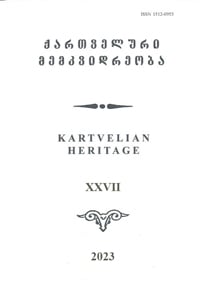GEORGIAN MATERIAL IN THE CONTEXT OF TURKISH PHONOTACTICS
Keywords:
Phonotactic rules of the Turkish language, prothesis, epenthesis, Georgian onomastic unitsAbstract
According to the phonotactic strategy of the Turkish languages, in the last syllablAccording to the phonotactic strategy of the Turkish languages, in the last syllable of a word, the wide labial vowel /o/ is replaced by the narrow labial vowel /u/. The Georgian name of the ridge Tortomi, located in the territory of Turkey today, was pronounced as Tortum by the Turks. Similarly, the Ĉoroḥi river was named Çoruh in Turkish. The town now known as Batumi, which is still Batomi in the Gurian dialect, was likely established with Turkish influence, leading to its Turkish-style name – Batumi. Pronouncing two or more consonants at the beginning of a syllable poses an insurmountable articulatory challenge for Turkish speakers. The words of Turkish origin do not typically contain the syllable CCV(C). Borrowed words with two or more consonants at the beginning of the syllable undergo phonological processing when they are “turkified,” involving a process called prothesis (where a vowel is added before two consonants at the beginning of a syllable) and epenthesis (where two consonants are split at the beginning of a syllable and a vowel is placed in the middle). This process helps overcome the clustering of consonants at the beginning of the syllable. Georgian toponymic data is utilized to demonstrate the functioning of prothesis. Speri is a region in historical southwestern Georgia, now known as İspir, a municipality in Turkey. Sṭepanċminda appears in a prothetic form in a fiscal document drafted in 1595, as recorded in ‘The Great Book of the Gurjistan Vilayet’: استڥانزمنده /istefānzmnda/. The Georgian toponym sķarebi has been rendered as اسكارب /isкarb/ by the Ottoman Turk defterdar. The same document indicates the national toponyms that feature an epenthetic vowel: blorĵa – /bulurĵa/, dgvari – /dugar/, zresķi – /zirsķ/, tmogvi – /tumk/, pruṭi – / purud/, ğjrṭila – /γirdla/, ċre – /ċire/, ċrioḥi – /ċirioḥ/, ċqorĵa – /ċuqurĵa/, ċqruti – / ċuqurt/, etc. In specific cases of prothesis, a vowel is added in front of foreign words starting with /r/ (note that words of Turkish origin do not start with /r/): Turk. Rum – Urum, Rus – Urus, Ital. roba – Turk. urba, Arab. rub’ ربع – Turk. urup, Pers. ruspi – Turk. orospu, etc. When Rustaveli’s ‘The Man in the Panther Skin’ was translated into Turkish, the names of the characters – Rostevan and Pridon – underwent adaptation to the phonotactic features of Turkish: Erestevan (i.e., a vowel appeared before /r/), and Feridun - where the /e/ vowel was integrated into the consonants of the Georgian /pri-/ syllable. The manifestation of the prothetic phenomenon is evident in the name of our capital in Turkish: not Tbilisi, but Tiflis. The Turk faced difficulty in pronouning the / tb/ consonants of the /tbi-/ syllable, so he split it by inserting the vowel /i/ to overcome this challenge and pronounce it as Tiflis. The influence of Turkish on Georgians living in Turkey is so strong that the pronunciation /Tiblizi/ has been observed in their speech as well.

